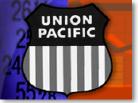|
UP's downs bode ill
|
 |
July 23, 1998: 12:26 p.m. ET
Railroad's poor results plus growing bottlenecks could hurt transport sector
|
NEW YORK (CNNfn) - A bloody earnings report from Union Pacific Corp. Thursday and recent signs of traffic bottlenecks during the busy late summer season are adding up to a threatening outlook for the transportation sector.
Union Pacific Thursday released a disastrous second-quarter financial report, tallying up to an operating loss of 64 cents a diluted share. Wall Street was expecting a loss of only around 17 cents a share.
Despite the surprise, UP shares (UNP) were trading up 1/8 at 42-5/16 Thursday morning, as analysts already had discounted the stock in anticipation of negative news. In fact, the railroad's stock price has been at a low point for several weeks.
(Click here for a chart of UP's stock price)
"I think the UP earnings are probably a good foreshadowing of what the U.S. transportation sector will experience in the second half as bottlenecks develop and the system comes under stress," said Jim Winchester, an analyst with Lazard Freres in New York. "Their earnings were pretty brutal."
Evidence of those expected bottlenecks is beginning to loom, starting overseas.
Ships carrying goods from Asia to the United States already are brimming with cargo, forcing some shipments to stay on Asian docks and wait for later ships with room to spare.
"Ships are pretty full and people are getting bumped," said Bill McCurdy, commerce and transportation counsel for DuPont Co. "Our stuff is getting through, but smaller shippers and those without guaranteed-space contracts are getting hit."
The surge of cargo is causing stress as it moves through the transportation chain.
The railroads that are picking up this surge of cargo on the West Coast and carrying it to major cities in the Midwest and on the East Coast are starting to feel pressure, according to transportation industry executives.
"The rail situation is not as bad as it was last year, but there are delays of 48 to 72 hours in some areas," said Ray Keene, executive vice president of Mitsui O.S.K. Line (America) Inc., a Japanese ocean carrier.
Last year, confusion on the rail system operated by Union Pacific, which was in the midst of absorbing the Southern Pacific Transportation Co., caused major delays and tie-ups across the Midwest.
Those traffic problems have been reverberating through UP's financial results, including the just completed second quarter, ever since.
"We've been working on a number of things to improve our service, and that has a cost," said UP spokesman John Bromley. In addition, UP, to make up for last year's debacle, has had to reimburse customers and pay damages to key customers. The railroad took a $155 million charge to cover these reimbursement costs.
The company reported an operating loss per diluted share of 64 cents, versus a loss of 87 cents for the year-earlier period. The company's net loss was $419 million, or $1.70 per share, compared with a gain of $216 million, or 87 cents per share, a year earlier. The current quarter's results include a $261 million charge, or $1.06 a share, for shedding the railroad's trucking unit, Overnite Transportation. Revenues for the quarter were $2.36 billion, compared with $2.65 billion a year ago.
For the first half of 1998, Union Pacific reported a net loss of $481 million, or $1.96 per diluted share, including the Overnite special charges. That compares with year-ago income of $344 million, or $1.39 per diluted share. Revenue was $4.7 billion versus $5.2 billion for the year-earlier period.
So far this year, operations appear to be going more smoothly for Union Pacific, although the latest surge of cargo appears to be testing the system.
"It's gotten pretty tight over the last week, especially in Southern California. There's been a huge volume of cargo coming in," UP's Bromley said.
"Overall, our system is fluid, but we'll get a full sense of where things are when the season hits its peak," said Jim Sanbourin, a spokesman for Burlington Northern Santa Fe Corp., the other main railroad serving the West Coast.
Typically, late summer and early fall is the peak season for the U.S. transportation system, as manufacturers and retailers move to build up inventories in anticipation of a holiday rush. According to transportation executives, the traffic, enhanced by a strong dollar overseas, already is beginning to build.
The Port of Long Beach, Calif., the nation's busiest general cargo port, says inbound cargo for the first nine months of its fiscal year is up 14.9 percent. June saw the port's third straight record.
(Click here for Long Beach's traffic stats)
"With the exchange rates the way they are, a lot of imports are coming over," said Don Wylie, director of trade and maritime services for the port. "It's a very busy, busy year. …And everybody is nervous."
Anxiety is particularly high because of the pending U.S. grain crop. If it comes in at record volume, which is expected at this point, it could strain the U.S. rail system.
"If everything doesn't go just right there could be a hit … it's a very fragile system out there," said McCurdy of DuPont.
-- by staff writer Allen Wastler
|
|
|
|
|
|
Union Pacific
BNSF
|
Note: Pages will open in a new browser window
External sites are not endorsed by CNNmoney
|
|
|
|
 |

|

